Mark Sisson's Blog, page 12
January 20, 2023
New and Noteworthy: What I Read This Week—Edition 205

Research of the Week
NAC protects against COVID infection.
Donating blood might be one way to lessen the risk of Parkinson’s.
The effects of cousin marriage bans in the US.
Heart rate during competition predicts athletic success.
Muscles control liver circadian rhythm.
New Primal Kitchen PodcastsPrimal Kitchen Podcast: The Link Between Dairy Intolerance and Dairy Genes with Alexandre Family Farm Founders Blake and Stephanie
Primal Health Coach Radio: The Truth about Vitamin E with Dr. Barrie Tan
Media, SchmediaA hypothesis about fairy circles.
Interesting Blog PostsWhen you need high dose biotin.
On ancestral diets, hydration, and salt.
Social NotesSomething new is coming.
“But animal fat is making you fat!”
Everything ElseSuicides increased when kids went back to in-person school.
Disguising solar panels as ancient Roman tiles.
Things I’m Up to and Interested InInteresting podcast: Regarding PUFA and child neurological development.
One of my favorite studies: Two eggs a day keeps the short stature away.
Interesting tool: “Google search” for the contents of books.
Of course: Animal foods are very important for sustainable and healthy diets.
Bronze Age Spanish island diet: Meat and vegetables.
Question I’m AskingHow’s the new year going so far?
Recipe CornerGreat way to eat more mushrooms (and shrimp).Homemade salt-packed anchovies.Time CapsuleOne year ago (Jan 1 – Jan 20)
10 Productivity Hacks That Really Work—What are they?Dear Mark: Should Teens Take Creatine—Probably.Comment of the Week
“What doesn’t kill you makes you stronger.“
-Pretty good heuristic from Jerry.
(function($) { $("#dfVRDTS").load("https://www.marksdailyapple.com/wp-ad..." ); })( jQuery ); 
The post New and Noteworthy: What I Read This Week—Edition 205 appeared first on Mark's Daily Apple.
January 18, 2023
11 Tools That Can Help You Achieve Your Health and Fitness Goals
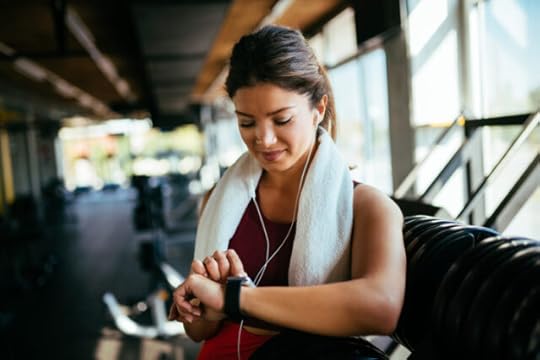 Despite being rational humans, we don’t always act in our own best interest. We know we should eat certain foods to look good, feel good, and get healthier, but often succumb to junk food that tastes good in the moment but makes us feel worse in the long term. We know getting to bed before 10 pm makes us perform better the next day, but it’s fun to stay up late. This is the human experience: the push and pull between our rational higher minds and what feels good in the moment. This is most evident in our relationship to working out.
Despite being rational humans, we don’t always act in our own best interest. We know we should eat certain foods to look good, feel good, and get healthier, but often succumb to junk food that tastes good in the moment but makes us feel worse in the long term. We know getting to bed before 10 pm makes us perform better the next day, but it’s fun to stay up late. This is the human experience: the push and pull between our rational higher minds and what feels good in the moment. This is most evident in our relationship to working out.
Working out is hard. It’s work. We are applying intense stress to our bodies and getting uncomfortable enough that the body’s only response is to get stronger, faster, and to adapt to the stress. That’s what makes it work, but it’s also what makes it hard to do: it’s not “fun” in the purest sense of the word. There’s pain, sweat, and grueling effort. Hardest of all, we have to want to work out . Most of us can’t get fit through daily living. We work in offices, sit at desks, drive in cars. We aren’t hunting, gathering, exploring, climbing as part of our daily lives anymore. It’s a choice we must make.
Today, I’m going to list a number of tools (low- and high-tech) and techniques to help making the right choice easier. Whether we like it or not, we don’t always do what we know we should—myself included—so this post is for all of us. Here are eleven tools and tips that will give you that little nudge you need to stay on track and do what’s best for yourself.
Set a GoalA lot of people fail because they never even set a goal. Now, a goal can be almost anything. You can aim for a certain amount of weight to lose or inches to shave off your waist. You can try to hit a specific weight on the squat rack or a time on the mile run. Your goal can be more broad, like “run a marathon.” It can be hyper-specific, like “run a marathon in under three hours.” It can be flexible, like “hike 50 miles a month” rather than “12 miles a week.” Your goal can even be “do something fun and active every day” or “play more often.” But the point is that you should probably have a goal of some sort in order to achieve a goal.
Heart Rate MonitorI’m not a big fitness tracking guy, but I recognize their utility for certain people. A heart rate monitor is probably the best overall option for people because it allows you to track your heart rate and heart rate variability. Why are these important?
Knowing your heart rate throughout a workout helps you adjust intensity to hit your goals. If you’re trying to build up cardiovascular and aerobic capacity, you’ll want to perform low level aerobic activity while keeping your heart rate under “180 minus age.” If you’re 40, that means your target aerobic heart rate is 140. Stay under that and you’re burning mostly fat and building your aerobic capacity. Go over and you’re burning a larger percentage of glycogen. The heart rate monitor tracks that for you.
Knowing your heart rate variability (HRV) in the morning upon waking can tell you how recovered you are and how prepared your body is for a workout that day. A higher HRV means you’re recovered and can push it. A lower HRV means you’re still in recovery mode and should take it easy. HRV is also a good general biomarker to track for overall health.
A WatchA cheap sports watch will do wonders for anyone who runs or sprints and cares about their times. Easiest way in the world to time your sessions, track your speed, and observe your progress.
You can go fancy and get a Garmin or an Apple Watch, but that’s not necessary for most people with smartphones (unless they want to track HRV as well).
Aesthetic Notebook for Tracking WorkoutsTracking your progress, especially in the weight room, is a great idea for people . When it’s on paper, it’s real. When you know exactly how much you lifted last workout, you know exactly how much to lift next workout. You can look back on your progress and get a nice burst of dopamine, and you’ll be more likely to stick with the program.
There are plenty of apps and spreadsheets and high tech tools for recording workouts, but I find a physical notebook with really high quality paper and an expensive pen make for the best fitness tracking. Barring that, the basic “Notes” app on your phone works too.
StravaThe beauty of Strava is two-fold. First, it turns your smartphone (or other activity-tracking device like a watch or heart rate monitor) into a high-powered activity-data gathering device. Before an activity, you activate Strava and it will track your vital stats and later you’re able to pore over and analyze the data. Second, it acts as a fitness-based social media feed. You see what your Strava friends are up to and they see what you’ve accomplished. You compare, compete, and encourage each other.
It’s great for data lovers who enjoy obsessing over the minutiae of performance and recovery. It’s great for people who derive motivation from competing with their friends or need encouragement from others. It’s particularly good for social media addicts who want to divert their obsessions into more fruitful enterprises.
FatbetFatbet is a throwback to a simpler time online. Make a Fatbet by setting a fat loss goal and placing a wager that you will reach the goal. Convince other people you know to make Fatbets and place wagers, too. If you lose your Fatbet, you must pony up the wager, whether it’s money, donations to charity, personal favors, or buying dinner for the winners. By drawing on mankind’s innate drive to win bets and defeat opponents, Fatbet can help keep you making the right choices on your path to losing weight. This seems like a good choice. It doesn’t necessarily involve money, if that’s not your thing, but it should be effective because everyone likes winning.
Zombies Run!Zombies Run! is a gamified fitness app that combines real world running, walking, or cycling with zombie-related storylines. Put your headphones on/earbuds in, start jogging, then start the mission. As you run, the story develops and the GPS tracks you or counts your steps. Maybe you’re taking supplies to a local township. Maybe you’re rescuing some stranded civilians. It could be anything. And at any moment, zombies can burst out and give chase, forcing you to really push yourself. It’s actually quite a clever idea and gets great reviews on the iPhone and Android App Stores.
The Jerry SeinfeldSeinfeld’s method of staying productive while avoiding day-crippling bad decisions is decidedly low-tech and is normally used for getting work done or doing chores, rather than reaching health and fitness goals. But that’s okay. It’s easily modified. You set a few goals (like “lift heavy things” or “eat no grains”), set daily minimums for each goal, devise boundaries and strategies for each goal, print out a calendar for each goal, and procure a big red pen. Every time you hit the daily minimum for a given goal, make a big red “X” on the day of the given goal’s calendar. If you miss a daily minimum, you don’t get an X. Strive to get an X on each day of each calendar. Chain them together. Don’t break the chain!
I like this one. First, I’m a Seinfeld fan, so I might be biased. Two, it’s simple and it requires the user to interact with real-world objects: pen and paper. On the computer, it’s easy to minimize a window, switch to a different browser, ignore email updates, or just never visit the website that logs your unfulfilled commitments, but a calendar on the wall or your desk stares you in the face. It’s right there in your line of vision, and if you want to avoid it you have to physically remove it. I suppose you could use an online motivational calendar like Streaks, but I wonder if the effect would be the same.
CronometerThere are lots of food trackers, but I think the best is Cronometer. The free app and desktop version have everything you need, and if you upgrade to the premium version (for a pittance) you get access to more customization. All the entries source nutrient info from official food databases, so if you want to know how much methionine, glycine, and folate is in beef sirloin with the fat cut off, you can get that info and trust that it’s based on the best possible
Gymnastics Rings Hung in Your HouseGymnastics rings are the best bang for your buck workout tool to keep laying around. Hang it from a rafter or a doorframe. If that doesn’t work, try a tree branch outside. Just hang it up somewhere you often visit, and then every time you pass by it, do some pull-ups, dips, or rows. It’s that simple.
Movement Alarm ClockI like this one a lot. Set the alarm to go off every thirty minutes or so, and use it as motivation to get up and do a set of pushups, pullups, and/or squats or do a microworkout just to keep active throughout the day. If you sit a lot at work (or even if you’re a standup workstation superstar), using a basic alarm clock to keep moving every hour (at least) should keep some of the negative health effects of sitting at bay. You know you shouldn’t be sitting for that long, and the clock is free, so you really have no excuse.
Before you know it, you’ve been hitting a set or two of exercises every hour, going for a short walk every two or three, gotten stronger, fitter, leaner, and accumulated a large amount of training volume without thinking about it or going to the gym. It’s almost magic.
Not everyone needs a dedicated tool to keep on the straight and narrow, but I’d wager that very few of us are completely rational actors who make nothing but logical decisions each and every day. Even something as simple as the alarm clock method or the Seinfeld method could be useful. The only way to really know is to try it out yourself.
Have you used any of these tools to reach your goals? I’d be interested in hearing about your experiences. Can you recommend any of your personal favorites that aren’t on this list? I’m sure readers would love to know more. Thanks for reading!
(function($) { $("#dfzvtAM").load("https://www.marksdailyapple.com/wp-ad..." ); })( jQuery );
The post 11 Tools That Can Help You Achieve Your Health and Fitness Goals appeared first on Mark's Daily Apple.
January 17, 2023
What is PEMF Therapy?
 In today’s world, we are constantly being exposed to electromagnetic fields, which tends to make people nervous. Who hasn’t heard concerns about EMFs and their potential health harms? We’re supposed to keep our cell phones away from our heads, turn the wifi off at night, avoid living under big power lines.
In today’s world, we are constantly being exposed to electromagnetic fields, which tends to make people nervous. Who hasn’t heard concerns about EMFs and their potential health harms? We’re supposed to keep our cell phones away from our heads, turn the wifi off at night, avoid living under big power lines.
So it would make sense if you were wary of PEMF therapy. In both cases, the “EMF” stands for electromagnetic field (the P standing for pulsed). But while just-EMF is supposed to be harmful (although the degree to which we need to worry is still up for debate), the pulsed kind is supposed to offer wide-ranging benefits. What gives?
Let’s back up. PEMF therapy claims to use low-frequency electromagnetic fields to help your own electrified cells function more optimally. With chronic illness on the rise, PEMF potentially offers a non-invasive therapy that can be used in place of or alongside conventional treatments to enhance their effectiveness.
People have been using magnets for therapeutic purposes since ancient times, long before the principles of magnetism and electricity were fully understood. Modern PEMF technology has been around for decades and is well-studied, although much of the early research was conducted behind the Iron Curtain, so it perhaps feels newer than it actually is. But PEMF therapy isn’t new, nor does it fall under the realm of “alternative” therapies. It has been FDA-approved for healing nonunion fractures for over four decades. NASA has developed PEMF technology to be used in regenerating cartilage.https://technology.nasa.gov/patent/MS... ">1 There’s a decent chance that your allopathic doctor knows about it and may even have a PEMF device in their clinic.
Before trying it out for yourself, here’s what you need to know to get started.
How Does PEMF Therapy Work?First, you’ll need access to a PEMF device, which generally consists of a control unit attached to an accessory such as a paddle or mat. The accessory contains metal coils through which electricity is passed, generating an electromagnetic field. Simply place the paddle or pad over the treatment area, turn on the machine, and let it do its thing. Some machines come with pads the size of small throw blankets so you can treat your whole body at once.
While you lie there, a pulsed electromagnetic field (hence the name) is passing through your body. That sounds like the stuff of Dr. Frankenstein’s laboratory, but it’s not painful. You shouldn’t feel anything other than a pulsing or tapping sensation and perhaps some muscle contractions.
As the electromagnetic field passes through, it interacts with your body’s own electrical systems, if you will, to improve health. Exactly how it does that it still something of a mystery. The basic science is well-understood, boiling down to Faraday’s law of induction (for all the physicists in the crowd. The rest of us don’t need to get bogged down in the details, although I invite any of you physics-minded types to expound on electromagnetism in the comments.) But, if you keep drilling down to the fundamental how of it all, things start to get murky.
The general idea here is that when your cells aren’t functioning optimally or they can’t communicate with the cells around them, this forms the basis of many chronic illnesses. PEMFs seem to promote or restore healthy cellular functioning.
By my reading of the literature, PEMF therapy is best characterized as an “enhancer.” Instead of injecting some therapeutic agent or prompting supranormal physiological responses, PEMF enhances your body’s ability to do what it would ideally do naturally: maintain homeostasis, heal from injury, fight off foreign invaders, and eradicate dysfunctional cells (including cancerous ones). It clears the way for optimal functioning, removing barriers where they exist and facilitating the body’s ability to build, repair, and heal itself.
There are now thousands of studies demonstrating various mechanisms of action of PEMF therapy. These include but are not limited to https://www.ncbi.nlm.nih.gov/pmc/arti... ">2
Enhancing cellular energy by promoting ATP synthesis. (ATP, you may recall, is the “energy currency” that fuels all cellular processes.)https://www.ncbi.nlm.nih.gov/pmc/arti... ">3Acting on the cellular membrane. Restoring membrane potential and modifying the activity of receptors and ion channels, allowing for better passage of nutrients and oxygen into the cell and waste products out. Modifying the activity of proteins on the cell’s surface and impacting intracellular communication. Modulating gene expression.Improving circulation, perhaps by increasing nitric oxide production, which acts as a vasodilator, and promoting angiogenesis, or the formation of new blood vessels.https://www.ncbi.nlm.nih.gov/pmc/arti... ">4 This also boosts nutrient and oxygen delivery and waste product clearance. (Notably, though, PEMF also seems to exert anti-angiogenic effects on tumor cells, cutting off their blood supply.https://www.ncbi.nlm.nih.gov/pmc/arti... ">5 It also seems to disrupt harmful angiogenesis in rheumatoid arthritis.https://www.ncbi.nlm.nih.gov/pmc/arti... ">6) Increasing cerebral blood flow.https://www.ncbi.nlm.nih.gov/pmc/arti... ">7Reducing inflammation.https://www.ncbi.nlm.nih.gov/pmc/arti... ">8Entraining brain rhythms and modulating neurotransmitter activity.https://pubmed.ncbi.nlm.nih.gov/19189... ">9. Stimulating growth factors that aid in the generation of bone and tissue.https://www.sciencedirect.com/science...Regenerating neuronal cells.https://ntrs.nasa.gov/api/citations/2... ">11What Is PEMF Therapy Used For?Because PEMF therapy seems to promote healthy cellular physiology, and every tissue and organ in the body boils down to cells, PEMFs could theoretically be applied anywhere there is dysfunction or dysregulation. Indeed, if you pop “PEMF and [any medical problem]” into Google Scholar, you’ll probably get a hit.
This is not to say that PEMF therapy is the magic bullet we’ve all been waiting for, ready to eradicate all disease so we can achieve our centenarian aspirations. Any proponents who are being honest will tell you that it’s hard to predict if PEMF therapy will be successful for a given individual and, if so, how long it will take. Insofar as PEMF seems to boost the body’s innate healing and homeostatic processes, it can only do so much. Your body has to do the rest.
Still, PEMF therapy shows promise across an impressively wide array of conditions thanks to the mechanisms of action listed above, plus many others. To give you a taste:
Fractures, Bone HealthThis was one of the earliest applications for PEMF and is still a popular non-surgical therapy for non-union fractures, which are bone fractures that refuse to heal. PEMF therapy stimulates osteoblasts (bone building cells) and suppresses osteoclasts (bone degrading cells). A recent 2020 meta-analysis confirms that PEMF helps fractures heal faster and more quickly.https://pubmed.ncbi.nlm.nih.gov/32495... ">12
Similarly, PEMF therapy can help mitigate bone loss, improve bone mineral density, and reduce pain in people with osteoporosis.https://pubmed.ncbi.nlm.nih.gov/30603... ">13
ArthritisBoth rheumatoid and osteoarthritis may benefit from PEMF thanks to its anti-inflammatory action and how it it promotes collagen deposition in joints.https://pubmed.ncbi.nlm.nih.gov/35586... ">14 There’s also evidence that PEMF stimulates special cells in the joints called mesenchymal stromal cells that play a vital role in healing and repair.https://www.ncbi.nlm.nih.gov/pmc/arti... ">15
PainPain management, especially chronic pain, is a vexing problem for medical providers or patients thanks to analgesic drugs’ long-term side effects, which are often significant. PEMF doesn’t just mask pain but targets the underlying inflammation and edema that cause pain after injury or surgery,https://pubmed.ncbi.nlm.nih.gov/28060... ">16 as well as in chronic pain conditions like back painhttps://www.ncbi.nlm.nih.gov/pmc/arti... ">17 and fibromyalgia.https://www.ncbi.nlm.nih.gov/pmc/arti... ">18
Mental Health and Neurological DisordersElectromagnetic therapies have long been used in treating brain issues like depression, but PEMF should not be confused with electroconvulsive therapy (a very intense therapy reserved for severe depression) or the more common transcranial magnetic stimulation (TMS). The latter is conceptually similar to PEMF, with low-frequency electromagnetic stimulation applied to the brain, but it is more targeted and designed to induce neuronal firing. It also can only be used in a clinical setting. PEMF targets the entire brain and can be used at home.
We have some evidence that PEMF can be a safe and effective treatment modality for depression,https://pubmed.ncbi.nlm.nih.gov/27449... ">19 and there is much interest in its potential to help with other neurological disorders such as Parkinson’s and Alzheimer’s.
CancerPEMF therapy won’t cure cancer, but where it might shine is as an adjuvant treatment that increases the effectiveness of conventional treatments and decreases negative side effects. In in vitro studies, PEMF induces cancer cell apoptosis (cell death).https://www.ncbi.nlm.nih.gov/pmc/arti... ">20
Long COVIDUntold numbers of people are going to be struggling with post-COVID symptoms such as persistent respiratory issues, weakness, and fatigue in the coming years. PEMF might help by reducing inflammation, improving microvasculature, reducing rouleaux formation in the blood (the clumping together of red blood cells), or other mechanisms. There are already some published case reports documenting benefits.https://www.ncbi.nlm.nih.gov/pmc/arti... ">21 https://www.frontiersin.org/articles/... ">22 and at least one registered clinical trial. This could be a game-changer.
Is PEMF Therapy Safe?As I said, most concerns regarding PEMF safety are due to inappropriately conflating PEMFs with EMFs from electronic devices and power lines. PEMF therapy devices have been studied for decades and are being used every day in medical clinics and homes around the world without any reports of serious adverse effects.
More to the point, PEMF therapy devices are not the same as the EMFs people are worried about when they talk about “electro-smog.” Furthermore, even if you wanted to avoid electromagnetic fields, you couldn’t. The Earth itself emits a pulsed electromagnetic field. Solar radiation—the sunlight hitting your skin that is so essential for health that I made sun exposure one of the 10 Primal Blueprint laws—is electromagnetic.
YOU are electromagnetic. The human body is basically electrified meat wrapped around a skeleton. EEGs measure electrical activity in the brain. You’ve heard about electrolytes and their critical role in everyday functioning. Well, the electro in electrolytes refers to the fact that electrolytes are ions that carry a positive or negative charge and facilitate electrical activity in the body. In short, don’t be put off by PEMF because of the “electromagnetic” part.
There are a few considerations to bear in mind, though. Occasionally, people do report mild discomfort when using the device, but this should dissipate over time. Some people may be hypersensitive to electromagnetic fields and so might be more prone to experiencing side effects like fatigue, brain fog, or dizziness. These folks may want to avoid PEMF therapy or at least proceed slowly.
You should consult a doctor before starting PEMF therapy if you have any implanted metal devices, are pregnant, or taking any prescription medications. There is a possibility that PEMFs could increase the drugs’ absorption rate, potentially leading to toxicity.
Choosing a PEMF DeviceMany companies now manufacture devices for home use. They range in price from a few hundred dollars to thousands of dollars and into five figures for the highest-end models. Which one to choose?
I’d say the best course of action, especially if you intend to use PEMF to address a specific health issue, is to talk to a practitioner familiar with using PEMF to treat your condition. PEMF applications differ in terms of the intensity, frequency, and waveform (shape of the wave), as well as the frequency of treatment, length of each treatment session, and total duration. You want to try to choose the most effective one. In truth, though, nobody knows with any certainty what exact PEMF protocol is best for a given individual or a particular disorder. Still, try to find someone to point you in the right direction, ideally someone who doesn’t have skin in the game. (If a salesperson tells you their device is definitely best for you, back away slowly. They’re selling you unfounded promises.).
Understand that PEMF therapy can be an expensive and time-consuming proposition. In some studies, participants are using their devices for ten or more hours a day for months at a time. If you’re going to make that investment, it’s worth getting the best device you can afford. If you can, start by finding a doctor in your area who has a PEMF device that you can test drive for a while to see if you notice any benefit before purchasing one yourself.
Bottom LinePEMF therapy is certainly intriguing. Sure, it’s not something our ancestors would have had access to. That is, unless you consider grounding. Grounding, or earthing, is the practice of walking barefoot to “plug in” to the Earth’s electrical field. Although some of the claims associated with earthing seem a little far-fetched, it’s pretty easy to see the potential overlap between low-frequency PEMF and grounding. Is there something there? Maybe.
In any case, the idea of using a non-invasive, seemingly low-risk devise to improve cellular communication and energy is appealing.
To be clear, although I highlighted the positive effects of PEMF therapy here, plenty of studies also show no benefit (but also no harm). This may be because the researchers in the null studies simply used ineffective protocols. There’s no way to know without more data.
Finally, the current research understandably focuses on specific medical issues more than general health and longevity, but I’m sure a lot of you are more interested in how PEMFs could be used to keep the system fully charged, so to speak. Proponents of the technology will say that PEMFs can be used to maintain health and promote optimal well-being. And I can see why that might be the case. Unfortunately, that kind of thing is hard to test (and will never get research money thrown at it).
What do you think? Does this technology pique your interest? Have you used it before, and if so, what were your results?
(function($) { $("#dfRVbMT").load("https://www.marksdailyapple.com/wp-ad..." ); })( jQuery ); 
References https://technology.nasa.gov/patent/MSC-TOPS-96 https://www.ncbi.nlm.nih.gov/pmc/articles/PMC8370292/ https://www.ncbi.nlm.nih.gov/pmc/articles/PMC6902701/ https://www.ncbi.nlm.nih.gov/pmc/articles/PMC6320690/ https://www.ncbi.nlm.nih.gov/pmc/articles/PMC5119968/ https://www.ncbi.nlm.nih.gov/pmc/articles/PMC6409305/ https://www.ncbi.nlm.nih.gov/pmc/articles/PMC6340641/ https://www.ncbi.nlm.nih.gov/pmc/articles/PMC8370292/ https://pubmed.ncbi.nlm.nih.gov/19189041/ https://www.sciencedirect.com/science/article/pii/S0753332220309604https://ntrs.nasa.gov/api/citations/20030075722/downloads/20030075722.pdf https://pubmed.ncbi.nlm.nih.gov/32495506/ https://pubmed.ncbi.nlm.nih.gov/30603841/ https://pubmed.ncbi.nlm.nih.gov/35586276/ https://www.ncbi.nlm.nih.gov/pmc/articles/PMC6409305/ https://pubmed.ncbi.nlm.nih.gov/28060214/ https://www.ncbi.nlm.nih.gov/pmc/articles/PMC6806956/ https://www.ncbi.nlm.nih.gov/pmc/articles/PMC6191958/ https://pubmed.ncbi.nlm.nih.gov/27449361/ https://www.ncbi.nlm.nih.gov/pmc/articles/PMC5119968/ https://www.ncbi.nlm.nih.gov/pmc/articles/PMC8743351/ https://www.frontiersin.org/articles/10.3389/fmed.2022.879971/full
The post What is PEMF Therapy? appeared first on Mark's Daily Apple.
January 10, 2023
Are Canned Vegetables Healthy?
 I’m lucky to live in warm climates with year-round access to fresh produce, but not everyone can pop over to their local farmer’s market or co-op whenever they want and grab the ingredients for a big-ass salad. Farm-to-table cuisine is great, the Primal ideal even, but the reality is that cooking with fresh, local ingredients requires access and time to shop and prepare food that not everyone enjoys, not always. Many people rely on preserved food for much or all of the year to meet their meat and produce needs, “preserved” meaning frozen, canned, dried, or fermented.
I’m lucky to live in warm climates with year-round access to fresh produce, but not everyone can pop over to their local farmer’s market or co-op whenever they want and grab the ingredients for a big-ass salad. Farm-to-table cuisine is great, the Primal ideal even, but the reality is that cooking with fresh, local ingredients requires access and time to shop and prepare food that not everyone enjoys, not always. Many people rely on preserved food for much or all of the year to meet their meat and produce needs, “preserved” meaning frozen, canned, dried, or fermented.
Whenever the topic of canned food comes up, I inevitably get questions about whether canned vegetables are nutritious, safe, or even Primal. (And I inevitably get comments about how we don’t need vegetables at all, which I discuss in my Definitive Guide to the carnivore diet.) Sure, Grok wouldn’t have eaten canned vegetables. But modern humans spend almost every minute of every day engaging with technology our ancestors couldn’t have imagined, from highly engineered mattresses topped with cooling pads to regulate our sleep temperature to air fryers to whatever device you’re reading this post on right now.
So I’m not too concerned about drawing some Primal line in the sand at food canning. The other questions are important, though. How does canned food stack up to fresh or frozen?
Are Canned Vegetables as Nutritious As Fresh or Frozen?It depends on which vegetable and which nutrient you look at, but in general, canning tends to reduce nutrient content compared to fresh or frozen vegetables. But that’s not true across the board. Sometimes, specific nutrients are actually higher in canned offerings.https://pubag.nal.usda.gov/catalog/72... ">1 https://pubag.nal.usda.gov/catalog/72...
Furthermore—and this is a crucial point—nutrient losses due to canning often even out by the time the food makes it to your plate. Canning exposes food to high heat, so much of that nutrient loss is essentially due to the “cooking” that canned food undergoes. Most frozen vegetables only withstand a quick blanching before being flash frozen. Thus, if you compare fresh, frozen, and canned vegetables immediately after harvesting and processing, canned generally looks the worst, nutrient-wise. However, research shows that canned vegetables maintain their nutrient levels as they sit on the shelves, whereas the nutrients in frozen and fresh vegetables tend to degrade, bringing them more on par with canned. Once you factor in storing and then cooking fresh and frozen vegetables, you find that the initial disparities are much less pronounced as you’re forking it into your mouth.https://ucanr.edu/datastoreFiles/608-...
Clearly, the best choice is fresh vegetables consumed as close to harvesting as possible. The reality, though, is the produce at your supermarket may be many weeks out from when it was picked, making it less “fresh” than you might imagine. There’s also the whole issue of seasonal and regional availability to consider.
Overall, in terms of building a nutrient-dense diet, in most circumstances, canned vegetables are going to be just as good or nearly as good as grocery store or frozen vegetables.
BPA Concerns in Canned FoodsNutrient content isn’t the only consideration when weighing canned versus fresh or frozen vegetables. There’s also the can itself. I have historically avoided canned vegetables in the store due to concerns over BPA in the can linings. (Home-canning in jars is different, of course. I’m all for home canning.) BPA is a known endocrine disruptor linked to immune system dysfunction, cancer, reproductive issues, and more. Since scientists and health watchdog groups have sounded the alarm about BPA in the past decade, industry reports suggest that almost all American manufacturers have moved away from BPA-lined cans.https://www.cancentral.com/content/in...
While that seems like a positive step, the BPA lining was there for a reason: to prevent corrosion and help preserve the food inside. Manufacturers replaced it, by necessity, with other types of materials that are supposed to be safer—“supposed to” being the operative words here. However, at this point, it’s hard to pinpoint exactly what materials are being used by which manufacturers and, more importantly, how they are being tested for safety. Thus, I can’t say with any certainty that these new linings are better.
How Long Do Canned Foods Last?Food waste is a massive global problem that is both economically and environmentally costly. One way we can reduce food waste is by learning what the expiration dates on our pantry items really mean. According to the USDA, “best by” dates aren’t about food safety but food quality.https://www.usda.gov/media/blog/2013/... After those dates, the flavor and texture may start to take a hit, but canned foods are still perfectly edible.
There’s certainly no reason to throw canned food away simply because it is a week, a month, or even longer past its best by date. Canned foods stay good for up to five years in your cupboard, though you’ll want to use more acidic items like canned tomatoes within a year or so. Home-canned foods should be used within a year, ideally.
Just use common sense (and your nose). If a can looks damaged—rusted, bulging, or badly dented—it’s not worth taking a chance. Likewise if the food inside has a strange odor. Texture changes, slight discoloration, and crystallization are not signs that the food is spoiled.
Bottom LineFor the most part, I continue to opt for fresh, frozen, or shelved food in glass packaging when available. The notable exception is canned fish. The convenience of a canned sardine or anchovy, and the benefits of the omega-3s they deliver, means they still have a standing place in my cupboard.
Some items are hard to find outside a can, though. Cooked beans don’t come frozen (another argument for skipping legumes?), and while they’re easy and affordable to prepare from dried, that requires preplanning. If beans are a staple in your home, consider preparing big batches and freezing them in individual portions. Tetra Paks are becoming more common for things like stewed tomatoes and soups, but there are questions about their sustainability. They are technically recyclable, but many recycling facilities don’t have the proper machinery, so they end up in a landfill. And glass can be more expensive, which matters especially when the cost of groceries is on the rise.
If you’re going to choose canned foods for reasons of convenience or availability, still look for “BPA-free” on the label. Don’t leave canned tomatoes sitting on the shelf for months at a time. It gives the acidity more time to erode the lining. Buy them close to when you are ready to use them. Same goes for canned fruit. If you are laying up food for emergency preparedness, look at dehydrating as an option.
That about covers it. Anything I missed?
(function($) { $("#dfKm6wB").load("https://www.marksdailyapple.com/wp-ad..." ); })( jQuery ); 
References https://pubag.nal.usda.gov/catalog/722423 https://pubag.nal.usda.gov/catalog/721800https://ucanr.edu/datastoreFiles/608-722.pdfhttps://www.cancentral.com/content/innovations-food-canshttps://www.usda.gov/media/blog/2013/06/27/you-toss-food-wait-check-it-out
The post Are Canned Vegetables Healthy? appeared first on Mark's Daily Apple.
December 27, 2022
Keto-friendly Vegetables
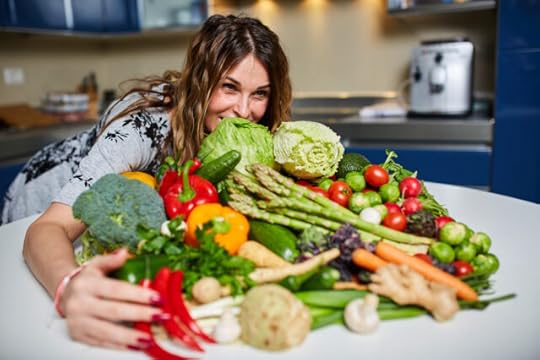 When the keto diet first skyrocketed in popularity in the late 2010s, it quickly gained a reputation as the “bacon and butter” diet. Vegetables might appear on one’s plate as a small side of spinach or, more likely, cauliflower masquerading as everything from rice to pizza crust to wings. By and large, the focus was on limiting consumption to “keto vegetables” while focusing mainly on increasing fat intake. (I’m talking mainstream keto, mind you, not the Primal Keto Reset approach.)
When the keto diet first skyrocketed in popularity in the late 2010s, it quickly gained a reputation as the “bacon and butter” diet. Vegetables might appear on one’s plate as a small side of spinach or, more likely, cauliflower masquerading as everything from rice to pizza crust to wings. By and large, the focus was on limiting consumption to “keto vegetables” while focusing mainly on increasing fat intake. (I’m talking mainstream keto, mind you, not the Primal Keto Reset approach.)
This, as you’d expect, led to no end of pearl-clutching from mainstream medical professionals and the popular media, who quickly branded keto as a dangerous fad diet, a heart attack in the making. It was true that many early adopters of keto went hard on butter, cream, cheese, bacon, and other high-fat foods, probably as an understandable backlash against the low-fat diet dogma that dominated the previous four decades. Some people still do, I’m sure.
However, I think most keto folks now understand that they cannot (or should not, anyway) live on butter alone. At least in more forward-thinking health circles, contemporary keto looks less bacon-and-butter and more like a lower-carb version of the Primal Blueprint way of eating, complete with bountiful salads and larger servings of protein.
Personally, I’m all for keto eaters embracing a wide array of produce (keto-carnivore diets notwithstanding). At some point, though, the carb question comes into play. By definition, keto requires you to limit your carbohydrate intake to keep glucose and insulin low enough to facilitate ketogenesis. All vegetables contain carbohydrates, some more than others. You can’t eat unlimited amounts of vegetables, especially the higher-carb ones, if you want to stay in ketosis all the time.
So how do you decide which ones are best?
What Vegetables Are Best for Keto?In order to achieve ketosis, most people need to limit carbohydrate intake to a maximum of 30 to 50 grams per day. Hence, the best vegetables to include on a keto diet are the ones that deliver the most nutrients with the fewest carbs. That sounds straightforward, but in practice, it can be hard to know where to draw the line.
The internet is rife with lists that sort foods into discrete “allowed on keto” and “not allowed on keto” categories. They mean well—and they do help simplify the often confusing transition from SAD eating to keto—but they lack nuance. No food will knock you out of ketosis in a single bite. There are no “bad” vegetables. There are only serving sizes and carbohydrate content and fiber.
Why does fiber matter? Because fiber is not absorbed into the bloodstream and converted into glucose. It’s counted as a carbohydrate, but it does not contribute to the glucose-induced insulin spike you want to minimize on keto. Fiber, especially the soluble type, is mostly just food for your gut microbes. From a ketosis perspective, fiber is neutral.
And in vegetables, especially the leafy and above-ground non-starchy varieties, much of their carb content is actually fiber, meaning their glucose/insulin impact is minimal. So much so that I don’t even count these varieties against the 50 grams of (total) carbohydrates I recommend as the limit in the Keto Reset. They’re not the only vegetables allowed on keto, just the easiest to enjoy in abundance.
My Favorite Vegetables for KetoWithout further ado, these are my top vegetables to enjoy on keto. If your favorite doesn’t appear here, never fear. You can still include it, I’m sure. This list is half based on personal preference, half on carbohydrate and nutrient content. Many vegetables that don’t appear on this list would still be considered “keto-friendly” even by the strict keto police; they’re simply not ones I gravitate towards first.
1. Bitter greensKale, arugula, mustard greens, endive, dandelion greens, turnip greens, collard greens, broccoli rabe, watercress. Increasingly, science is finding that bitter foods have unique metabolic and gut health benefits.
2. Other leafy greensSpinach, lettuce (all types), for my Big-Ass Salads
3. CauliflowerSo versatile it has become a joke in the low-carb world, but that’s just because it’s great in so many dishes. Who am I to argue?
4. Broccoli and broccoliniIs there anything better than crispy roasted broccoli next to a big, juicy steak? And the sprouts contain sulforaphane, a compound with impressive features that might make broccoli sprouts the next big superfood.
5. Bok choyOne of the sulfur-rich vegetables that may help the body buffer oxidative stress. And it’s delicious sauteed or added to stir-fries.
6. Green beansA classic.
7. Mushrooms (all varieties)Besides their pleasing textures and umami flavors, mushrooms pack prebiotics to nourish your gut bugs.
8. AsparagusHigh in vitamin K, excellent grilled, roasted, or air-fried, and you can wrap it in bacon. (Hey, I didn’t say you shouldn’t eat bacon on keto.)
9. CabbageEspecially when fermented into sauerkraut or kimchi. Everyone should eat fermented vegetables.
10. Fiddlehead fernsMy dark-horse pick. I just think they deserve more publicity.
What about avocados?Obviously, avocados get a big yes from me, but they’re also a fruit. I’m not putting them on my list of favorite keto vegetables, lest the entire internet come for my head.
Why Eat ANY Vegetables on Keto?You don’t HAVE to. But as I’ve said about the carnivore diet before, I think most people probably do better in the long run eating at least some vegetables. Rather than completely excluding plant foods, I’d recommend something like “carniflex,” a meat-centric diet with strategic plant additions.
Regardless, most Primal folks are omnivores, so they want and need strategies for incorporating vegetables into their keto macros. In that case, here’s what you should keep in mind:
Any vegetable can work on a keto diet. Some just happen to be relatively higher in carbohydrates than others (beetroot, parsnips, celeriac, for example).Prioritizing above-ground leafy and non-starchy vegetables lets you pack your plate with colorful fare without meticulously counting carbs. Since these foods contain a good deal of fiber (low net carbs), their glucose and insulin impact (and hence their likelihood of interfering with ketosis) is minimal. They also deliver a wide array of nutrients and keep your meals varied and interesting. Adjust serving sizes as needed. For higher-carb vegetables—think ones that grow below ground or that taste sweeter—look up the carb content of a typical serving in a tool like Cronometer. Make sure you aren’t blowing a huge chunk of your daily allotment on a small serving of a single food.Ok, those are my top 10. What would you have included?
(function($) { $("#dfzy0IE").load("https://www.marksdailyapple.com/wp-ad..." ); })( jQuery ); 
The post Keto-friendly Vegetables appeared first on Mark's Daily Apple.
December 23, 2022
New and Noteworthy: What I Read This Week—Edition 204

Research of the Week
Less autophagy, more heart disease.
Donating blood might be one way to lessen the risk of Parkinson’s.
Ketones may help chemotherapy patients (again).
Even if aspartame doesn’t increase anxiety in humans as it does in rodents, what do you have to lose by using stevia or monk fruit instead?
The more boosters a person had, the greater their risk of getting COVID.
New Primal Kitchen PodcastsPrimal Kitchen Podcast: The Link Between Dairy Intolerance and Dairy Genes with Alexandre Family Farm Founders Blake and Stephanie
Primal Health Coach Radio: Using Data to Guess Less and Help More with Risa Groux
Media, SchmediaStrict carnivore now hitting TikTok.
Because the FDA has done so well elsewhere.
Interesting Blog PostsBetter conditions beget more evolved differences between the sexes.
How plant-based diets might worsen menstrual symptoms
Social NotesDon’t let this be you.
“But animal fat is making you fat!”
Everything ElseI’m still blown away by the increase in ultra processed food consumption in this country—from 5% of calories to over 60%.
Things I’m Up to and Interested InCrazy to realize: Always great when a German bank does better research than the USDA.
Concerning: We’re still getting fatter.
An easy law to abuse: CA doctors will soon face censorship of any advice that conflicts with conventional wisdom.
Interesting research: LSD appears to have huge effects on genes and proteins related to neuroplasticity and neurogenesis.
How is this possible?: Big variation in outcomes among people with LDL over 190.
Question I’m AskingWhat are you doing for Christmas?
Recipe CornerEasy pork shoulder roast with peach glaze.Classic nog.Time CapsuleOne year ago (Dec 10 – Dec 23)
7 Herbal Alternatives to Hormone Replacement Therapy, or HRT—What are they?Dear Carrie: Hot Flashes—My wife weighs in.Comment of the Week
“I launched a Friday Family Fun Night initiative here where every other friday 5-10 dads get together at a gym with their kids and we all just play hard in a free unstructured setting. Dodgeball, tag, nerf battles, tug of war, whatever comes up. It’s glorious.“
-Great way to get kids and parents playing from Don.
(function($) { $("#dfb8mj6").load("https://www.marksdailyapple.com/wp-ad..." ); })( jQuery ); 
The post New and Noteworthy: What I Read This Week—Edition 204 appeared first on Mark's Daily Apple.
December 22, 2022
Keto Chicken Parmesan
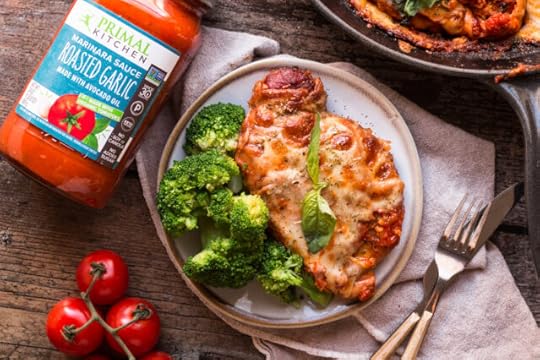 There’s nothing more comforting than the rich tomato flavor of a classic Italian dish. However, those regularly practicing a keto lifestyle or starting a Keto Reset Diet may wonder if homestyle Italian cuisine is out of reach. This delicious keto chicken parmesan recipe proves that you don’t have to leave your comfort food favorites behind while traveling the keto path.
There’s nothing more comforting than the rich tomato flavor of a classic Italian dish. However, those regularly practicing a keto lifestyle or starting a Keto Reset Diet may wonder if homestyle Italian cuisine is out of reach. This delicious keto chicken parmesan recipe proves that you don’t have to leave your comfort food favorites behind while traveling the keto path.
Our recipe substitutes Primal Kitchen Roasted Garlic Marinara for the laborious, day-long sauce that typically accompanies traditional chicken parmigiana, making for a quick and easy weeknight meal. We prefer cooking our chicken parmesan in a cast-iron pan for flavor and the hemoglobin iron boost, but you can use any oven-safe pan. Serve alone, with pan-roasted vegetables, or atop keto-friendly noodles.
How to make keto chicken parmesanFirst, use a food processor or blender to pulverize the pork rinds into a coarse flour. Mix the pork rind powder in a bowl or dish with the almond flour, garlic powder, oregano, salt and pepper. Whisk your eggs in another bowl or dish. Dredge each cutlet one at a time in the egg mixture, allow the excess egg to drip off, then dredge the cutlet on both sides in the flour mixture. Set each cutlet aside and repeat with the rest of them.
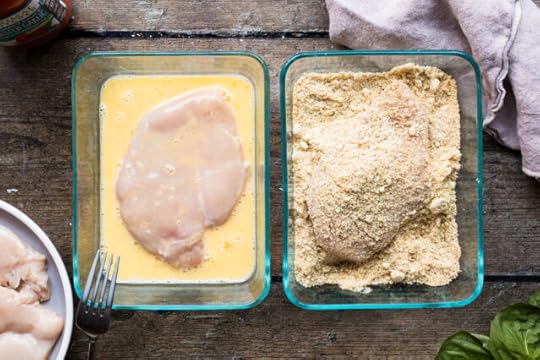
Preheat your oven to 375 degrees Fahrenheit. Heat the olive oil in a large oven-safe skillet on your stovetop over medium-high heat. Once hot, place the cutlets in the pan and sear for 4-5 minutes on each side. Depending on the size of your pan, you may need to sear the chicken in batches. Don’t crowd the pan or else you won’t get a nice crust on the chicken. After you have seared the chicken, place all of the cutlets in the pan. Place the pan in the oven until the internal temperature of the thickest cutlet reads 165 degrees Fahrenheit. Pour the roasted garlic marinara sauce on top of each cutlet and place the pan back into the oven for 3-5 minutes.
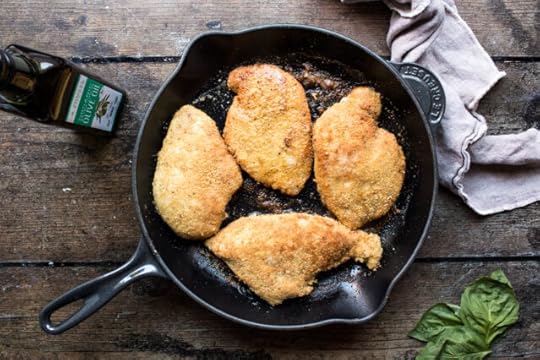
Take the pan out of the oven and sprinkle the chicken with the cheese. Increase the oven temperature to 450 degrees. Place the skillet back into the oven until the cheese is melted and browned. You can also use the broil function of your oven. Remove from the oven and top with black pepper and oregano and basil.

Serve with your favorite veggie side. We like simple roasted or steamed broccoli, sauteed zucchini, kale or spinach, or spaghetti squash.

 Keto Chicken Parmesan Author: Priscilla Chamessian
Keto Chicken Parmesan Author: Priscilla Chamessian  Total Time: 55 min
Total Time: 55 min  Yield: 6 [image error] Print Recipe [image error] Pin Recipe Description
Yield: 6 [image error] Print Recipe [image error] Pin Recipe Description There’s nothing more comforting than the rich tomato flavor of a classic Italian dish. However, those regularly practicing a keto lifestyle or starting a Keto Reset Diet may wonder if homestyle Italian cuisine is out of reach. This delicious keto chicken parmesan recipe proves that you don’t have to leave your comfort food favorites behind while traveling the keto path.
Ingredients2 pounds chicken breast, pounded into ½” thick cutlets
1–2.5 ounce bag baked pork rinds (we used EPIC brand)
2/3 cup fine almond flour
1 tsp garlic powder
1 tsp dried oregano
1/2 tsp black pepper
1/4–1/2 tsp salt
2 large eggs
1/4 cup Primal Kitchen Extra Virgin Olive Oil
1.5 cups Primal Kitchen Roasted Garlic Marinara Sauce
1.5 cups shredded mozzarella cheese
Fresh basil
Instructions Use a food processor or blender to pulverize the pork rinds into a coarse flour. Mix the pork rind powder in a bowl or dish with the almond flour, garlic powder, oregano, salt and pepper.Whisk your eggs in another bowl or dish.Dredge each cutlet one at a time in the egg mixture, allow the excess egg to drip off, then dredge the cutlet on both sides in the flour mixture. Set each cutlet aside and repeat with the rest of them.Preheat your oven to 375 degrees Fahrenheit. Heat the olive oil in a large oven-safe skillet on your stovetop over medium-high heat. Once hot, place the cutlets in the pan and sear for 4-5 minutes on each side. Depending on the size of your pan, you may need to sear the chicken in batches. Don’t crowd the pan or else you won’t get a nice crust on the chicken.After you have seared the chicken, place all of the cutlets in the pan. Place the pan in the oven until the internal temperature of the thickest cutlet reads 165 degrees Fahrenheit. Pour the roasted garlic marinara sauce on top of each cutlet and place the pan back into the oven for 3-5 minutes.Take the pan out of the oven and sprinkle the chicken with the cheese. Increase the oven temperature to 450 degrees. Place the skillet back into the oven until the cheese is melted and browned. You can also use the broil function of your oven. Remove from the oven and top with black pepper and oregano and basil. NotesServe this dish with your favorite veggie side. We like simple roasted or steamed broccoli, sauteed zucchini, kale or spinach, or spaghetti squash.
 Prep Time: 15 min
Prep Time: 15 min Cook Time: 40 min Nutrition Serving Size: 1/6 of recipe Calories: 558.8 Sugar: 3.7g Sodium: 1047.6mg Fat: 31.3g Saturated Fat: 7.4g Trans Fat: .2g Carbohydrates: 9.9g Fiber: 2.4g Protein: 56.4g Cholesterol: 203.8mg
Cook Time: 40 min Nutrition Serving Size: 1/6 of recipe Calories: 558.8 Sugar: 3.7g Sodium: 1047.6mg Fat: 31.3g Saturated Fat: 7.4g Trans Fat: .2g Carbohydrates: 9.9g Fiber: 2.4g Protein: 56.4g Cholesterol: 203.8mg Keywords: keto chicken parmesan
 Did you make this recipe?
Did you make this recipe? Share a photo and tag @marksdailyapple — we can't wait to see what you've made!
The post Keto Chicken Parmesan appeared first on Mark's Daily Apple.
How to Handle Youth Sports as a Parent
 My kids are all grown up now, but from talking to friends and colleagues with younger kids, it’s become clear that youth sports has become too serious. Kids compete too much and too early. They overspecialize in sports at too young an age, then get burnt out and stop loving the sport altogether. They spend too much time doing the same thing with the same movement patterns. It monopolizes any free time the kids (and rest of family) have. And, perhaps most importantly, parents are too wrapped up in it all.
My kids are all grown up now, but from talking to friends and colleagues with younger kids, it’s become clear that youth sports has become too serious. Kids compete too much and too early. They overspecialize in sports at too young an age, then get burnt out and stop loving the sport altogether. They spend too much time doing the same thing with the same movement patterns. It monopolizes any free time the kids (and rest of family) have. And, perhaps most importantly, parents are too wrapped up in it all.
But it doesn’t exist in a vacuum. Kids love to play sports and need to move their bodies.
The foundation of all human movement is play—engaging in a broad spectrum of spontaneous moments, reacting to novel situations as they arise, associating movement with intrinsic reward and joy and pleasure. The problem is that the classic childhood culture of free play, which is how children have historically (and pre-historically) developed their ability to move through physical space and engage with the physical world, is disappearing from neighborhoods. Oftentimes the only chance a kid gets to move is by joining a competitive youth sports team.
So how can you make it work without getting out of hand? How can kids engage in youth sports without burning out, getting injured all the time, and hating what used to be enjoyable?
Keep it fun.They’re “playing” sports, remember? Playing. Playing is fun. It’s joyful. If you’re enrolling your kid in a legit youth sport recreation league, make sure the emphasis is on fun. That may mean calling the coach and talking about their philosophy and their goals for the kids.
Don’t criticize them on the ride home. Don’t badger them about missing a play or shot. If they start dreading going to practice, if they start making up excuses as to why they can’t go today, then listen. Pull back. Take it easy on them. Let them play sports. If you ruin sports, you might just ruin the idea of play altogether.
Delay competition as long as you can.A tale as old as time is the kid who starts a sport—maybe it’s wrestling—at age 5, has a knack for it, loves it, and starts competing before long. He wins a few tournaments, does well, wins more than he loses, but then by age 10 or 11, he’s lost interest. The sport he loved to play became a chore, a job, a source of stress and pressure. 10, 11, 12 year olds aren’t meant to deal with that kind of stress associated with a sport they’re supposed to love.
Meanwhile, the kids who get into a specific sport at age 12 after having spent their younger years playing and trying a bunch of new sports all the time excel, go on to compete at a higher level. There are exceptions, of course, but I’ve seen this happen over and over again.
Let them decide to compete.The desire to compete has to emerge from within. The human child is a complex being still in the flower of development. To grab them in the middle of development and throw them into a sport and say “Ok, now go compete at a high level” is to interrupt what could be a delicate process of growth. Humans are naturally competitive, but this competitiveness comes out at different time for different kids. Rushing it along might “spoil the batch,” if that makes sense. Like cooking, you have to honor the recipe.
Now, if they want to compete but balk as the moment arrives, you should push them. Nudge them into it. That’s just the pre-game jitters. As long as they made the initial decision, you can help them stick to it.
Don’t be the coach (unless you’re the actual coach).Oftentimes a parent will be the coach for the youth sports team. If that’s you, be the coach. Definitely be the coach. It’s your formal role. But don’t be the parent screaming from the sidelines. Don’t be the dad at practice calling out tips and adjustments to your kid, going above and around the coach. Don’t mix the worlds.
Consider a “movement” discipline instead of a sport.When kids are young and looking for a physical activity, consider a non-traditional alternative to classic sports.
A gymnastics and tumbling class down at the local recreation center.A parkour or ninja-training course at the local movement gym.Jiu jitsu, wrestling, or some other grappling martial art where kids will be rolling around, exploring dozens of different joint articulations, and “roughhousing” in a safe and controlled manner.Swimming is a legit sport, but a season or two of swimming can set them up for life with strong skills. No need to get competitive with it.This will give them the ability to move well, express their physical potential through time and space, make friends, build their stamina and endurance, and set them up well for any traditional sports they want to try in the future.
Play with balls.Keep a bunch of balls around the house and play with them with your kids.
Playing catch. Start with easy predictable throws and then progress to making them react to unpredictable throws. Dribbling with your feet and hands. Dribbling unconventional things, like tennis balls. The carryover to a basketball or soccer ball is huge and makes it much easier. Playing dodgeball. The classic schoolyard game, now banished or severely neutered in most schools, taught millions to dodge, contort their bodies, catch, and throw with great power and accuracy.
Just carrying a ball around, getting comfortable with it. Tossing it up and catching it while you walk. Tossing it while you watch TV. Idle play, so that it becomes part of you.
Give them their space.Unless you’re dealing with truly young kids who still need their parents from moment to moment, I’d recommend that you drop your kid off at practice and go find something else to do for an hour. If you’re going to watch, do it from afar where they can’t really see you. Don’t be front and center at practice. What you’ll find is that if you’re right there on the sidelines kids will constantly look to you for approval. They’ll scan your face for disappointment, or happiness. You don’t want that. You want your kids fully immersed in the game, doing it for themselves—not for you.
Let the field or wrestling room or track or court be their space that they learn to own. Consider it a little taste of separation.
Anything works as long as they’re moving.Variety is the spice of movement. There are hundreds of sports, physical activities, and skills
A sport isn’t even necessary. There’s:
DanceArcheryMartial artsHuntingBoxingParkourGymnasticsFencingHorse stuffRock climbing/boulderingTo name just a few.
Choose recreation leagues over travel leagues.At least when they are on the younger side, a more casual rec league makes more sense for most kids than a serious year-round travel league. It doesn’t take all your time. It’s not year round, so your kids can try different sports throughout the year. It’s not as expensive—you’re not renting hotels and spending money on planes and gas. It’s not as competitive and serious, which can force your kid into bad patterns—both movement and psychological.
You can always move up to the travel league if your kid expresses interest and has the chops for it. But choose rec leagues whenever possible, because it’s hard, if not impossible, to go back once you commit to travel.
Play multiple sports.The number one issue with the. I grew up playing every sport outside with my friends, roaming the neighborhood for pickup games, and simply getting into trouble everywhere I went. This made me the man and athlete I am today. I can play any number of sports and can still move well in part because I grew up playing everything. If that idyllic childhood experience is no longer available to your kids, you can at least help them get the same results by letting them play multiple sports, rather than focus on one. This also spreads the “movement load” to various tissues that might otherwise get overloaded and injured from repetitive motions.
When they get older, they can specialize all they want, but the best foundation for an athlete is playing everything.
Always be trying.They can try anything and they can quit if they don’t like a particular sport or physical activity—but they have to pick another. They must always be trying.
Ask yourself “Who’s it for?”Are you pushing your kid into sports for their benefit, or yours?
Now, there’s an argument that they might not know the benefits of the sport. Sports can have a multitude of long term benefits down the road: the friends you make, the skills and athleticism you develop, the camaraderie, the pressure you have to withstand, how you learn to temper the joy of victory and bitterness of defeat. These are all real considerations that your average 7 year old with an average time horizon isn’t factoring into their decision to play or not.
However, those benefits are more likely to emerge if the kid truly enjoys the sport. Pushing him or her into it against their will makes it less likely they’ll glean those positive lessons down the line and more likely they’ll resist them.
These are the things to keep in mind when making your child’s youth sports league experience optimal, ideal, and most importantly fun.
Take care, everyone. I’d love to hear your thoughts on youth sports.
(function($) { $("#dfKC1r1").load("https://www.marksdailyapple.com/wp-ad..." ); })( jQuery ); 
The post How to Handle Youth Sports as a Parent appeared first on Mark's Daily Apple.
December 19, 2022
10 Natural Health Benefits and Healing Uses of Lavender
 Humans have been using lavender as a culinary, cosmetic, aromatherapeutic, and hygienic herb for at least several thousands years. In the Bible, Mary uses lavender (“very costly”) to anoint the feet of Jesus. In ancient Egypt, embalmers used lavender in the mummification process. Roman bathhouses often scented the water with lavender petals and women throughout the Mediterranean—where it grows natively—used it in hair oils, perfumes, and makeup. It became so ubiquitous as a fragrance in cleansing agents and bathing that the name “lavender” itself comes from the root Latin word for washing—lavare.
Humans have been using lavender as a culinary, cosmetic, aromatherapeutic, and hygienic herb for at least several thousands years. In the Bible, Mary uses lavender (“very costly”) to anoint the feet of Jesus. In ancient Egypt, embalmers used lavender in the mummification process. Roman bathhouses often scented the water with lavender petals and women throughout the Mediterranean—where it grows natively—used it in hair oils, perfumes, and makeup. It became so ubiquitous as a fragrance in cleansing agents and bathing that the name “lavender” itself comes from the root Latin word for washing—lavare.
It turns out that the ancients were right about lavender. It is a valuable herb that you can use to enhance your health, sleep, cooking, baths, and overall quality of life by incorporating it into your daily routines and regimens.
Breathe in the aromaCrush fresh lavender between your finger and take a big whiff, or rub lavender oil on your temples for a soothing dose of aromatherapy stress relief. If you’re not sensitive to it, you can apply a little bit of oil or fresh lavender to your upper lip, so you get a steady drip of soothing lavender scent throughout the day. Lavender aroma relieves anxiety and mental tension.
Drink lavender teaThough it’s usually enjoyed for its aroma, lavender is also perfectly safe to consume and, as a tea, actually rather reminiscent of chamomile in its effects. Like chamomile, lavender tea improves sleep, reduces anxiety, and it can even lower depression scores.https://pubmed.ncbi.nlm.nih.gov/32444...
To make lavender tea, steep a handful of fresh lavender flowers (or two grams of dried flowers) in boiling water for 5-10 minutes. Strain and enjoy.
This is just as effective as chamomile for promoting sleep and helping to soothe frazzled nerves. You can even combine the two for synergistic effects.
Make perfumeLavender oil makes a nice, chemical-free alternative to perfumes and colognes, especially combined with a more woody scent like sandalwood. Dab a little at the back of your neck or wrists to smell clean and light.
To make it last longer, dilute the oil in the fat of your choice. MCT oil, olive oil, avocado oil, or even beef tallow are excellent mediums.
You can also steep the fresh or dried lavender flowers in the fat using a double boiler to warm it up and speed up the extraction; strain before it cools.
Take a Roman lavender bathThe Romans would add fresh lavender to their public baths. They ruled much of the known world for over a thousand years, so they knew a thing or two. Adding either oil or fresh lavender buds to a hot bath will make an already-relaxing bath even more relaxing via two routes—topical absorption and aromatic absorption.
Use lavender at bedtime to sleep more deeplyTie up fresh flowers and tuck them inside your pillow case, or just keep it beside your bed when you sleep. You can also do some inhalation before bed. Lavender also works well placed in a satchel, small pillow case, or reusable eye pillow.
Lavender helps you to sleep better, sleep faster, and sleep more deeply.
Topical lavender to soothe skinIs your skin burned, chafed or irritated? Add some lavender oil to your moisturizer or a spray water bottle and apply or mist your skin generously. You can also steep fresh lavender in a carrier oil, then apply to irritated, burned, or chafed skin.
Make sweet, fresh-scented laundryInstead of using chemical-laden dryer sheets, tie up a bundle of lavender blossoms in a cloth and add them to the dryer cycle when you do laundry. Be sure to shake out your clothes after they dry to get rid of any residue from the lavender. You’ll have to replace the lavender in between drying cycles.
Use lavender on cuts and scrapesLavender oil applied to wounds can actually improve and speed up wound healing. Add a few drops to carrier oil (coconut, olive, avocado) and apply it to wounds when they occur. Lavender has antiseptic properties, too, so the lavender oil blend can act as a comfortable alternative to more painful antiseptic sprays (great option for kids).
Use lavender on your scalpWhen applied to the scalp, lavender may stimulate the growth of hair follicles. It also exhibits anti-dandruff activity.
An easy way to make a lavender “shampoo” is to add a few drops of lavender oil to a single raw egg yolk. Apply to wet hair and rub it in. Leave it in for a couple minutes, then rinse.
Another option is to steep lavender as you would to make tea; allow to cool and use as a rinse daily until dandruff clears up.
Cook with lavenderLavender gives a unique floral accent to many dishes. It goes particularly well with lamb, grilled fruits, and higher fat cuts of meat. One really nice way to use it is to grill peach halves wrapped in bacon and then finish with fresh lavender flowers, crushed black pepper, and extra virgin olive oil. Another way is to add lavender to your smoker or BBQ when cooking lamb; the fragrant smoke lends a powerful effect.
Do be warned: a little bit of culinary lavender goes a long way.
As it turns out, lavender is much more than just a nice smell.
(function($) { $("#dfqXWmG").load("https://www.marksdailyapple.com/wp-ad..." ); })( jQuery ); 
References https://pubmed.ncbi.nlm.nih.gov/32444033/
The post 10 Natural Health Benefits and Healing Uses of Lavender appeared first on Mark's Daily Apple.
December 14, 2022
7 Exercises to Relieve Knee Pain

The knee is almost always the first joint to go when people “start getting old.” How many people do you know have given up any kind of serious physical activity because of their “bad knees”? How many people avoid the gym because their knees are supposedly too stiff? How many people take the elevator to go up a floor, avoid hikes because they can’t handle the hills, or give up on their favorite sports—all because their knees hurt?
It’s too many. It’s a damn shame, and it doesn’t have to be like that.
The knee is actually a very powerful joint. Surrounded on two sides and supported by powerful muscles, tendons, and ligaments, buttressed by cartilage and fascia, and capable of great feats of recovery and regeneration, the knee is stronger and more resilient than most people realize. However, the knee has to be cultivated and strengthened. It has to engage in various movements to help it get stronger and make it stop hurting. If you want to reduce knee pain—or stave it off before it happens—these are the knee strengthening exercises for you.
1. Couch Stretch

The couch stretch, a movement and term coined by Kelly Starrett of Ready State fame, is a stretch that undoes hours of sitting. When we sit, our hip flexors rest in a flexed position. They’re flexed but not flexed. It’s a passive flexion that leaves them tight and weak. Then, when we go to do some squats or any other dynamic knee-centric sport or movement, we have to deal with all that tension upstream of the knee.
Try squatting. Just a basic air squat. See how it feels to rest in the bottom position. Maybe it’s okay, maybe it’s hard. Either way, take a mental note of how you feel squatting. Next, try the couch stretch for a minute or two on each side. Then try squatting again. You should feel much less pressure on your knees and a greater ability to rest in the bottom position comfortably.
2. Knee Circles

Toperform the knee circles, place your hands on your quadriceps, just above the knee caps. Allow the weight of your upper body to push down and rest on your hands. Then, give a few slow knee bends, flexing and extending your knees to “set” your menisci. Begin doing slow knee circles, first clockwise and then counterclockwise. Do about 30 seconds in each direction slowly, gradually, and deliberately, and really feel like you’re hitting every angle of your knee.
Knee circles are great for people with meniscus issues. They allow you to compress every part of the meniscus and help generate the stimulus needed to promote healing and regeneration. Because they’re low intensity, slow, and deliberate, knee circles rarely hurt. If you feel a sharp pain, try reducing the angle of flexion. These are a great warmup before leg workouts, or even done every morning as a warmup for life.
3. Tear Drop Squats

The teardrop squat is named for its ability to target the teardrop muscle of the quadriceps, also known as the vastus medialis obliques (VMO). Located on the medial part of your quad, the VMO is an important muscle for controlling the alignment of the knee cap, preventing knee pain and can also improve the aesthetics (tear drop) of your legs. When your VMO is weak, your knee is liable to buckle inward. Thus, strengthening the VMO through targeted movements can both improve your performance and help prevent catastrophic injuries (many MCL and meniscus tears happen when the VMO fails and the knee buckles inward).
Traditional leg workouts often do not adequately target the VMO, but the teardrop squat can help to engage it by maintaining an upright torso and keeping the feet on the balls of the feet as you squat down, allowing little to no space between the glutes and calves at the bottom of the movement. This extremely deep knee position hits the VMO.
In this video, you can see Mark Bell, who coined the term and came up with the exercise, show how it works. Set up a resistance band across a squat rack and use as much or as little of it for assistance as you squat down and back up. Move your hands farther apart for more assistance. Move them closer together for less.
Tear drop squats are a good accessory lift to throw in at the end of workouts, or even a couple sets as a warmup for heavier leg days.
4. VMO Step Downs

VMO step downs are also a great exercise for strengthening the VMO that you can do almost anywhere. Stand on a step or a short box with one foot hanging off the side and step down, touch the heel of your hanging foot to the ground and then go back up. Do not push off with the hanging foot; all the work comes from the foot that’s planted on the step.
This is all knee flexion. There should be little to no hip flexion. Keep your torso upright and straight. Don’t bend or hinge at the hips.
5. Deep Knee Split Squats

To perform a deep split squat, start by reaching one foot far behind you and put one in front of you with your torso centered between both. Slowly lower yourself into a squat, pressing forward until your knee goes over your toes. Hold this position for a moment to feel the stretch in your ankle, knee, and quad. Then, press back and up to return to an upright position. Be sure to focus on the stretch in your ankle and knee as you perform the exercise.
If these are too easy unweighted, progress to weighted with dumbbells, weight vests, or even barbells. They can be a legitimate strength training workout on leg days, or you can keep it light as accessory work.
6. Tibia Raises

The tibialis anterior is the muscle running along the front of your shin. It controls ankle movement and stability, helps absorb the impact of knee flexion, and, most importantly, goes undertrained in the majority of people. A lot of knee pain occurs because the tibia is too weak to control the knee during the hard impactful flexion that occurs during jumping and landing, running and planting, and lifting.
Tibia raises involve starting with your ankle in plantar flexion (toes pointing down), then performing dorsiflexion (toes moving toward the knee) against a load (weight, band, etc). That’s it. You can do them standing or sitting. All that matters is starting in plantar flexion and performing dorsiflexion against a load.
To do tibia raises, you have a few options. My guy Brian in the gif below has attached a dumbbell to the straps of his sandals. There is also specialized equipment designed to help you do weighted tibia raises, or you can use resistance bands or weight room cable machines. Worst case scenario you can even do them without any weight at all. Tibia raises are a great accessory lift on leg days.
7. Backward Weighted Hill Walks

Walking backward up a hill with a weight vest on or carrying weights is a low stress way to increase quad activation, strengthen the muscles surrounding (and controlling) the knee, and promote blood and healing synovial fluid flow to the knee. It lubricates your knees and gets you prepared for further intensity. The real beauty of the backward uphill walk is there’s no eccentric—it’s all concentric. Doing these before any leg workout is a fantastic way to warm up your knees without exhausting them.
You can also do a weighted backward sled drag using a prowler, weight sled, or even an automobile.
If you suffer from knee pain or worry about incurring it, incorporate these 7 knee strengthening exercises into your training sessions. Even if you don’t have knee pain, there’s no downside to strengthening your knees and the muscles that support them.

The post 7 Exercises to Relieve Knee Pain appeared first on Mark's Daily Apple.
Mark Sisson's Blog
- Mark Sisson's profile
- 199 followers



